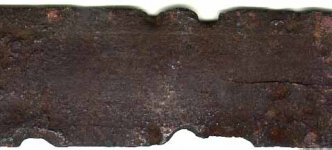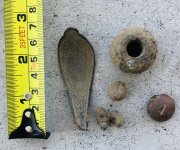chazman
Jr. Member
European swords can provide clues about a dig site, but they can also provide traps.
Oakeschott's typology broke them down into basic families and sub-families which can be roughly tied to regions and periods, but those are not rules. As releventchair noted, blades travel. If a sailor leaves a sword at a site, that sword could have conceivably come from nearly anywhere. Without additional evidence (such as other artifacts), the presence of that sword means nothing by itself.
The grip, guard, and pommel can tell us more, but again, they can also fool us. It was not uncommon at all for an older blade to be married to newer grip components or vice versa. Sometimes it was merely an expedient way to repair a broken weapon; at other times, it was done to "freshen up" an old weapon with more fashionable components. Those components can also be roughly tied to regions and dates, but not always; like some of the blade designs, some of those patterns went in and out of style over the centuries.
Sometimes very old weapons were recovered and pressed into service long after they'd went out of style. The sagas mention individuals breaking into burial sites to recover famous weapons. Additionally, our current understanding of which people used which weapons over what period of time are based on incomplete records. We have not dug up every sword buried out there, but even if we did, we would still be working from an incomplete record - not every sword wound up in a back yard or a river. This is why I dislike the term "Viking sword." The Vikings did not use only one style of sword, the styles that they used evolved over time, and they were not the only Europeans using those styles of swords at those particular times. The term actually covers the evolution from the Roman spatha all the way up to the Oakeschott Type XII, the so-called "knightly sword" that most people imagine when they think of a knight - and possibly after, depending on who you ask. This was quite a transition, lasting around 800 years or so, and resulted in a number of different designs along the way - the Migration Period swords, the Type X, etc.
Unfortunately, all we have in this case is a poor photograph of a chunk of rusty metal that may or may not have been from a sword, which corrosion may or may not have significantly changed the shape of. Assuming that it is a sword tip, the tip itself appears too pointy to be from the Migration Period, which hints at when it was made (but not when it was placed there!). Mrs. Hope tells us a bit about it: "...and he handed me a heavy object about 5 inches long, made of iron. When I'd cleaned it I could see that it was part of an ancient iron sword: the channel for the blood to run out was there." The mention of the fuller also hints at when it was made and would have been appropriate for a "Viking sword" from about 700 AD on. It's tempting to lock in on the fact that the fuller came to within 5" of the tip (this suggests a sword from the High Middle Ages or earlier), but this tip may not be from a sword - it may be from a large knife or a bayonet, in which case it could have ended up the ground only a couple of years earlier. That's assuming that it was in fact a fuller.
This does provide a good example of what I was talking about earlier, though...intelligent people can still be wrong, particularly if they're straying out of their lane. That "channel" is known as a fuller and is a feature that lightens a weapon without compromising its rigidity; it has nothing at all to do with blood. If it was indeed from a "Viking sword," it almost certainly wasn't made of iron. A sword guy could have told her that, had she asked. This is why it's important to have an expert look at something before jumping to conclusions.
you make some very good points. (yes, pun intended)
"Viking" swords were generally made of a soft iron core that was more springy-bendy-malleable, not as liable to break but the edge was harder steel which in many cases was imported. steel was valuable at the time so they didn't want to use too much of it. many axes and swords have been shown to have been re-edged when the good hard steel was worn through. Viking age thrift at it's best!
a simple set of tests could find out the source of the iron.
Viking age iron, especially the early stuff, was usually what is referred to as "bog iron". the iron was smelted from the rust coming up in the peat bogs of Denmark and Sweden as they didn't have any good access or hadn't found at that time the iron deposits in Norway. the bog iron was pretty crumby stuff, but it worked well enough when paired with some more expensive steel laminated along the edge.
the celts of Scotland made many of their swords the same general way, cheap iron in the middle, expensive steel on the edge.
in the picture I've attached you can see the line where the 2 metals are joined together quite clearly. this is an celtic example but shows the same general techniques as used by the Vikings in their sword production.






